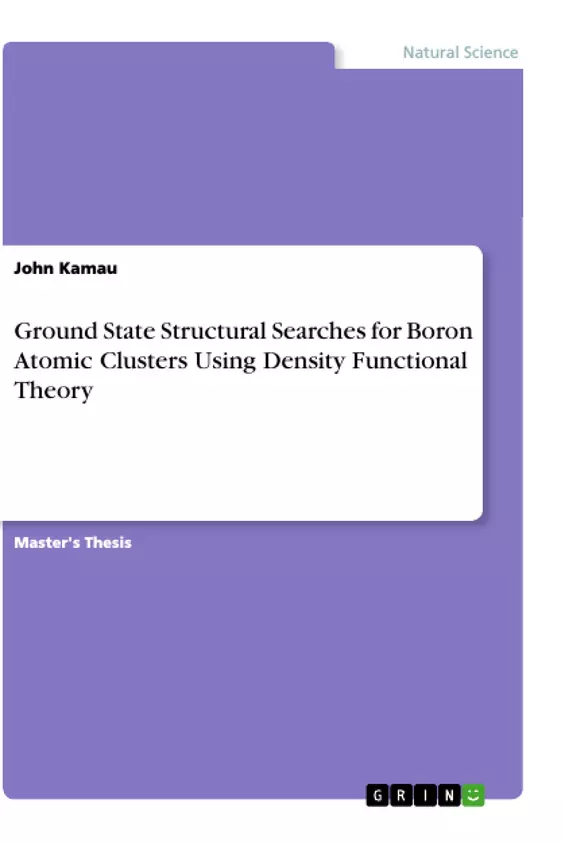Elemental boron has a fascinating chemical versatility that is unique among the elements of the periodic table. The study of the evolution of boron atomic clusters and their chemical and physical properties is of fundamental interest to researchers interested in nanotechnology. One of the most difficult problems in the study of boron clusters is finding their ground state cluster structures. The atomic arrangements in clusters are generally very different from those in corresponding bulk materials, such that chemical intuition cannot be trusted to generate optimal structures. An unbiased search method was used to search for these stable boron structures. It took advantage of the relative speed of the density functional-based tight binding (DFTB) method to identify low-lying local structures and then used the more accurate density functional theory (DFT) to find the ground state structures.
In this project we used a computational scheme to predict the best atomic arrangements of boron clusters. A completely unbiased search mechanism was implemented to determine optimal boron clusters. An approximate model was first used to locate minimum energy conformations followed by a more accurate first principles calculation to get the global minimum. Our results were then validated by comparisons to those reported in literature. The objective was to perform a consistent search of cluster sizes ranging from sizes n = 2-14, 16, 18 and 20. This was done to not only study where boron makes its transition from flat to three-dimensional clusters, but also to determine patterns in their evolution with size. The motivation behind our work and the long-term goal involved exploring the viability of the existence of large cage-like boron clusters, like B80, which have been proposed in literature as being extremely stable.
Inhaltsverzeichnis (Table of Contents)
- INTRODUCTION
- Overview of Atomic Clusters
- Boron Clusters
- Previous Studies of Boron Clusters
- Problem Statement
- THEORETICAL METHODS FOR ELECTRONIC STRUCTURE CALCULATIONS
- Overview
- Density Functional Theory (DFT)
- The NRLMOL Code
- Density Functional Based Tight Binding (DFTB) Method
- Comparison of DFT and DFTB Methods
- METHODOLOGY
- The Structure Prediction Problem
- Energy Minimization Methods
- The BIG BANG Algorithm
- Energy Correlations for DFT vs. DFTB and DFT vs. DFT1
- GROUND STATE STRUCTURAL SEARCHES FOR BORON CLUSTERS
- Creating Different Geometrical Volumes
- Tests to Find Optimal Parameters
- DFT vs. DFT1 Correlation for B12
- Potential Energy Comparison for DFT and DFTB
- Searching Different Sizes
- RESULTS
- The Lowest Energy Structure and Isomers for Bn Clusters (n = 2-14, 16, 18 and 20)
- DFTB Results for B80
- Binding Energy of the Clusters
- CONCLUSIONS
- Summary of Findings
- Recommendations for Future Research
Zielsetzung und Themenschwerpunkte (Objectives and Key Themes)
This thesis investigates the ground state structures of boron atomic clusters using density functional theory (DFT) and the density functional-based tight binding (DFTB) method. The study focuses on finding stable structures for clusters of different sizes, analyzing their binding energies, and exploring potential applications in nanotechnology.
- Ground state structural searches for boron atomic clusters
- Application of DFT and DFTB methods
- Analysis of cluster stability and binding energies
- Exploration of potential applications in nanotechnology
- Comparison of DFT and DFTB methods for accuracy and efficiency
Zusammenfassung der Kapitel (Chapter Summaries)
This section summarizes the main themes and arguments presented in each chapter of the thesis, excluding the final chapter and any sections containing major revelations or spoilers.
- Chapter I: Introduction This chapter provides an overview of atomic clusters, focusing on the unique properties of boron clusters and their relevance to nanotechnology. It also reviews previous studies on boron clusters and outlines the problem statement addressed by the thesis.
- Chapter II: Theoretical Methods for Electronic Structure Calculations This chapter introduces the theoretical methods used in the study, including density functional theory (DFT) and the density functional-based tight binding (DFTB) method. It discusses the advantages and limitations of each method and how they are applied to study boron clusters.
- Chapter III: Methodology This chapter describes the methods used to predict the ground state structures of boron clusters. It focuses on the structure prediction problem, energy minimization methods, the BIG BANG algorithm, and the correlations between DFT and DFTB methods.
- Chapter IV: Ground State Structural Searches for Boron Clusters This chapter details the practical application of the methodology described in Chapter III. It presents the strategies used to create different geometrical volumes, optimize parameters, and compare the results obtained from DFT and DFTB methods.
- Chapter V: Results This chapter presents the results of the ground state structural searches, highlighting the lowest energy structures and isomers identified for different cluster sizes. It also analyzes the binding energies of the clusters and discusses the potential implications of the findings.
Schlüsselwörter (Keywords)
This thesis focuses on the study of boron atomic clusters using density functional theory (DFT) and the density functional-based tight binding (DFTB) method. Key terms include: boron clusters, ground state structures, DFT, DFTB, binding energy, nanotechnology, structure prediction, energy minimization, and the BIG BANG algorithm.
- Quote paper
- John Kamau (Author), 2008, Ground State Structural Searches for Boron Atomic Clusters Using Density Functional Theory, Munich, GRIN Verlag, https://www.grin.com/document/1133315



